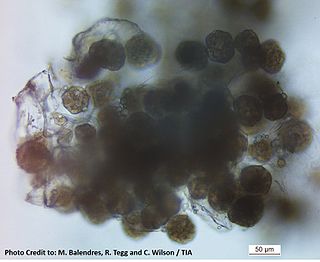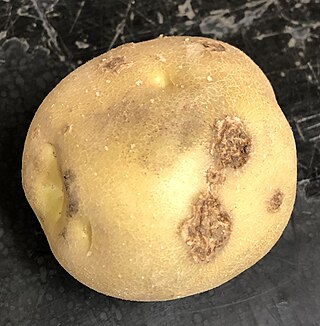
Streptomyces is the largest genus of Actinomycetota, and the type genus of the family Streptomycetaceae. Over 700 species of Streptomyces bacteria have been described. As with the other Actinomycetota, streptomycetes are gram-positive, and have very large genomes with high GC content. Found predominantly in soil and decaying vegetation, most streptomycetes produce spores, and are noted for their distinct "earthy" odor that results from production of a volatile metabolite, geosmin. Different strains of the same species may colonize very diverse environments.

Kerr's Pink is a potato cultivar in wide production in Ireland and the United Kingdom and many other countries. Although often quoted as an "Irish potato", the cultivar was actually created by J. Henry of Cornhill, Scotland, in 1907.

Powdery scab is a disease of potato tubers. It is caused by the cercozoan Spongospora subterranea f. sp. subterranea and is widespread in potato growing countries. Symptoms of powdery scab include small lesions in the early stages of the disease, progressing to raised pustules containing a powdery mass. These can eventually rupture within the tuber periderm. The powdery pustules contain resting spores that release anisokont zoospores to infect the root hairs of potatoes or tomatoes. Powdery scab is a cosmetic defect on tubers, which can result in the rejection of these potatoes. Potatoes which have been infected can be peeled to remove the infected skin and the remaining inside of the potato can be cooked and eaten.
Streptomyces scabiei is a streptomycete bacterium species found in soils around the world. Unlike most of the 500 or so Streptomyces species it is a plant pathogen causing corky lesions to form on tuber and root crops as well as decreasing the growth of seedlings. Along with other closely related species it causes the potato disease common scab, which is an economically important disease in many potato growing areas. It was first described in 1892, being classified as a fungus, before being renamed in 1914 and again in 1948. Several other species of Streptomyces cause similar diseases to S. scabiei but other, more closely related species, do not.
Butte is a potato cultivar that was released in 1977.

Common scab is a plant disease of root and tuber crops caused by a small number of Streptomyces species, specifically S. scabies, S. acidiscabies, S. turgidiscabies and others. Common scab mainly affects potato, but can also cause disease on radish, parsnip, beet, and carrot. This plant disease is found wherever these vegetables are grown.

Bintje is a middle-early ripening potato variety bred in the Netherlands by the Frisian schoolmaster K.L. de Vries in 1904 from and marketed for the first time in 1910. The name of the potato, a diminutive of Benedict, was borrowed from one of his former students.
Streptomyces europaeiscabiei or is a streptomycete bacterium species that is associated with common scab in potatoes. Its type strain is CFBP 4497T.
Streptomyces stelliscabiei or is a streptomycete bacterium species that is associated with common scab in potatoes. Its type strain is CFBP 4521T.
Streptomyces reticuliscabiei is a streptomycete bacterium species that is associated with netted scab in potatoes. Its type strain is CFBP 4517T. It is considered to be part of a cluster together with S. turgidiscabies, however they cause different diseases, the former involved in common scab.
Streptomyces acidiscabies is a streptomycete bacterium species, causing a scab disease of potatoes. Its type strain is RL-110.
Streptomyces turgidiscabies is a streptomycete bacterium species, causing scab in potatoes. It has flexuous spore, the latter which are cylindrical and smooth. The type strain is SY9113T. It is almost identical to Streptomyces reticuliscabiei; however, they are considered distinct species given the diseases they cause are different.
Streptomyces puniciscabiei is a streptomycete bacterium species known to cause potato common scab disease in Korea. Its type strain is S77T. It has purple-red, spiny spores that are borne in simple rectus flexuous spore-chains.
Streptomyces niveiscabiei is a streptomycete bacterium species known to cause potato common scab disease in Korea. Its type strain is S78T. It has white, smooth, cylindrical spores that are borne in simple rectus flexuous spore-chains.
Streptomyces araujoniae is a bacterium species from the genus of Streptomyces which has been isolated from a potato tubercle.
Streptomyces melanosporofaciens is a bacterium species from the genus of Streptomyces which has been isolated from soil in Italy. Streptomyces melanosporofaciens produces elaiophylin, cyclooctatin, geldanamycin, chilaphylin and melanosporin. A mutant of Streptomyces melanosporofaciens has the ability to protect potatoes from common scab.
Streptomyces microflavus is a bacterium species from the genus of Streptomyces which has been isolated from soil. Streptomyces microflavus produces nemadectin, fattiviracin A1, milbemycin and deoxyuridines. Streptomyces microflavus also produces the ionophore valinomycin. Streptomyces microflavus is also known to cause potato common scab disease in Korea.

Solanum commersonii is a species of wild potato in the family Solanaceae. It is native to southern Brazil, Uruguay, and northeastern Argentina, and has been introduced to Mauritius. It is being extensively studied for its resistance to root knot nematode, soft rot, blackleg, bacterial wilt, verticillium wilt, Potato virus X, tobacco etch virus, common scab, and late blight, and for its frost tolerance and ability to cold acclimate, in an effort to improve the domestic potato Solanum tuberosum.
Potato scab can refer to either:





